360 review template




360 feedback is changing, and traditional, checkbox-style evaluations no longer meet the expectations of business growth demands. In 2025, high-performing organizations are shifting toward skill-based, feedback-driven performance management models.
Thoughtfully crafted for HR professionals and managers in the tech industry, the 360 review template from Kadar offers four distinct templates — for self-assessment, peer, direct report, and upward reviews — designed to support structured conversations and real development plans. Whether you’re implementing a 360 performance review, facilitating a review for direct reports, or collecting peer performance reviews, this resource gives you everything you need to run impactful reviews that drive both individual and team performance.
Self-assessment performance review template
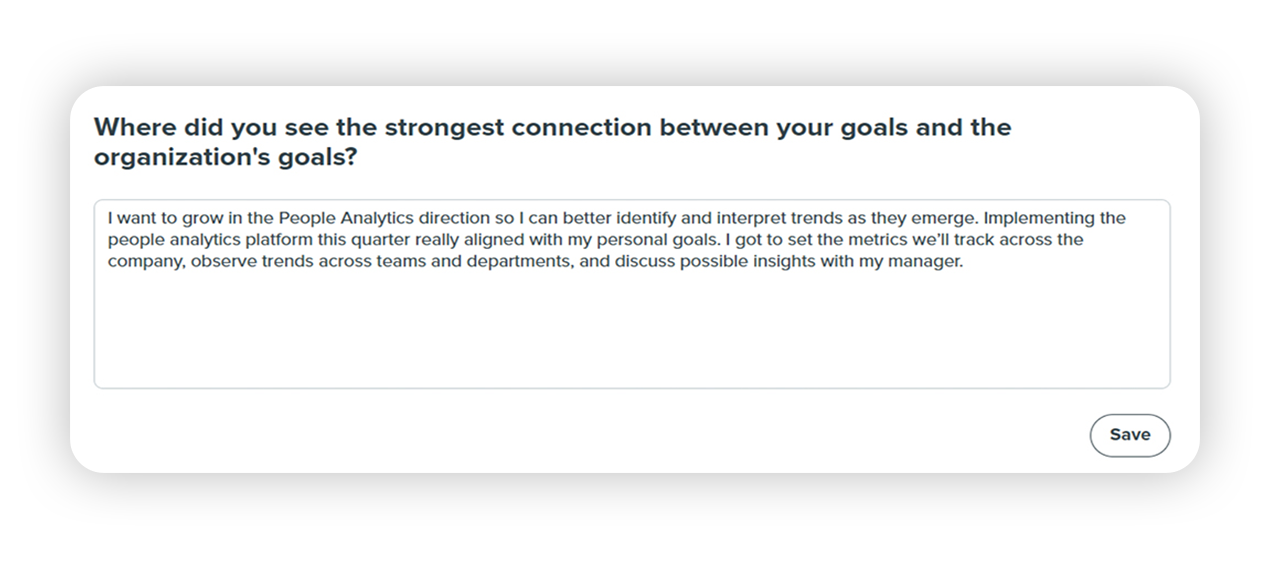
Who is this template for
The self-assessment part of the 360 review template is ideal for tech employees at all levels, managers preparing for direct report reviews, and HR leaders seeking to enhance their performance review cycle. It works particularly well in organizations that value self-driven growth and open communication.
When to use self-assessment in the talent development process
The performance review self-assessment is an essential tool in today’s talent development practices, best used as a starting point in any formal 360 review process. Whether conducted semi-annually, quarterly, or at key project milestones, a self-assessment performance review provides valuable context before a direct report review or a 360 performance review. It allows employees to reflect on their achievements, evaluate the challenges they faced, and assess how their goals align with organizational objectives.
By encouraging employees to articulate their own perspectives on performance, you foster a sense of ownership and increase engagement in the review process, especially in the tech industry, where autonomy and self-direction are highly valued.
When to avoid this review type
The self-assessment review is not a replacement for comprehensive feedback from managers or peers, nor should it be used as a mere formality to satisfy HR processes. It’s ineffective when treated as a stand-alone document without follow-up discussions or when used in organizations that lack a genuine commitment to employee development.
How to effectively use this template
As part of reviews for 360, start by sharing the performance review self-assessment at least a week before formal review meetings. Encourage employees to reflect on which goals they met, which they struggled with, and what contributed to both outcomes. The template also prompts them to consider their well-being, learning experiences, and professional development goals for the next period.
🎯 Expert insight: Even though some organizations assess performance separately from well-being, learning, or development, reflecting on these areas together often provides a more complete picture of what drives both individual growth and performance outcomes.
This isn’t just a form to fill out, but a conversation starter. Use the completed self-assessments to guide deeper discussions during one-on-ones, aligning personal goals with team objectives and discovering any support needs the employees may have.
Encourage thoughtful self-reflection
✅ Support specificity. Ask employees to highlight key projects, wins, and lessons learned.
✅ Normalize sharing challenges. Growth areas are as valuable as achievements.
✅ Link reflections to business goals. This shows impact and strategic thinking.
Why to use a self-assessment review in performance management
A self-assessment 360 review template goes beyond goal tracking. It encourages employees to think critically about their work, recognize their contributions, and identify areas for growth. Self-assessment promotes transparency and enhances communication between employees and managers.
🌱 Want employees to take ownership of their growth?
This performance review self-assessment template is a good start.
Peer performance review template
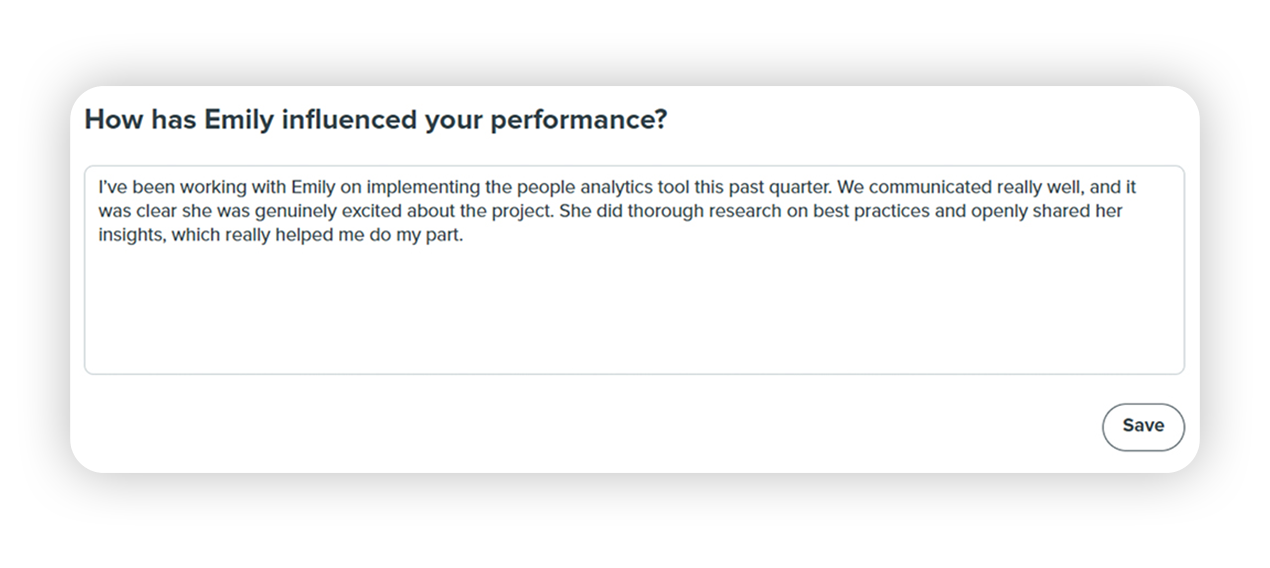
Who should use this template in your organization
The peer performance review template is intended for HR professionals managing reviews for 360, team leads facilitating project feedback, and managers looking to build a culture of openness and continuous improvement within their teams.
When peer feedback drives the most value in employee development
As part of the 360 review template, peer review plays a crucial role in a performance review cycle and is highly effective in collaborative, agile environments. Use it quarterly, biannually, or after significant project collaborations to capture feedback from employees who work closely together on a daily basis.
Peer feedback offers perspectives that managers may not have, particularly in areas such as interpersonal dynamics, teamwork, dependability, and feedback receptiveness. These insights are crucial in cross-functional teams, which are typical in tech organizations, where peer collaboration often drives project success.
When a peer-focused 360 review template won’t deliver value
Peer reviews should never be used as ranking tools or as a means for forced comparisons among team members. They also fail when used in organizations without a strong culture of trust, where feedback might be misused or misunderstood. They’re most effective when integrated into a feedback-rich environment where team members understand the value of mutual accountability.
Best practices for making this template work
Keep the process streamlined. A peer-focused 360 review template should focus on key areas: achievements, areas for improvement, influence on team dynamics, and responsiveness to feedback. Avoid overwhelming peers with too many questions. Instead, encourage honest responses that are both actionable and respectful.
To ensure authenticity, clarify the purpose of the review and, when appropriate, maintain confidentiality. Collect peer reviews before formal reviews or at the end of key projects, and use the insights alongside manager evaluations and self-assessments.
Quick tips on how to guide your team on giving constructive feedback
✅ Balance praise with useful insights.
✅ Emphasize confidentiality and developmental purpose.
✅ Focus feedback on observed actions, not personal traits.
Why peer feedback captures insights no one else can see
Unlike other review types, peer performance review highlights behaviors and skills that are best observed by colleagues, such as reliability, communication, and collaboration. They help build a culture of accountability and continuous feedback within teams.
🤝 Looking for a way to make peer reviews a tool for growth, not tension?
👉 Help your team give better peer feedback.
Direct report performance review template

Who benefits most from structured direct report reviews
This part of the 360 review template is designed for managers in the tech sector, HR leaders shaping performance management strategies, and team leads committed to promoting meaningful career development conversations.
When to use this review type in your performance review cycle
The direct report remains a cornerstone of talent development. It should be used in a formal 360 performance review, typically every six or twelve months, and also after significant projects or developmental milestones. Direct report performance review is particularly valuable when used alongside the employee’s self-assessment performance review, as it encourages alignment and shared understanding.
Don’t use this 360 review template solely for performance ratings
Direct report performance review should not be treated as a compliance requirement or used solely to justify pay decisions. It’s ineffective in organizations where reviews for 360 are disconnected from ongoing coaching and feedback. Reviews that are purely evaluative, without offering developmental support or follow-up, miss the mark.
How to conduct reviews for direct reports that promote growth
Use the direct report reviews in conjunction with self-assessments and peer feedback, guided by a structured 360 review template, to get a comprehensive view of the employee's performance. Assess how well they met their goals, what challenges they faced, and what impact they had on the team and organization.
This template guides managers in reflecting on their role in employee performance, encouraging honest dialogue about how leadership and support may have influenced outcomes. It also includes a structured assessment of readiness for advancement, helping to guide conversations about promotions or skill development opportunities.
Manager must-dos for a growth-oriented review
✅ Prepare with input from self-assessments and peer reviews.
✅ Foster open dialogue. Make space for the employee’s perspective.
✅ Define next steps clearly. Align on goals, support needs, and follow-up actions.
Why meaningful direct report reviews strengthen both trust and results
A structured direct report, review, as part of the 360 review template, allows managers to evaluate employee performance holistically, covering goal achievement, skill development, impact, and readiness for advancement. It’s not just about assessing past work but also about planning for future growth.
🎯 Turn every review into a leadership opportunity.
👉 Download the direct report performance review template now.
Upward performance review template
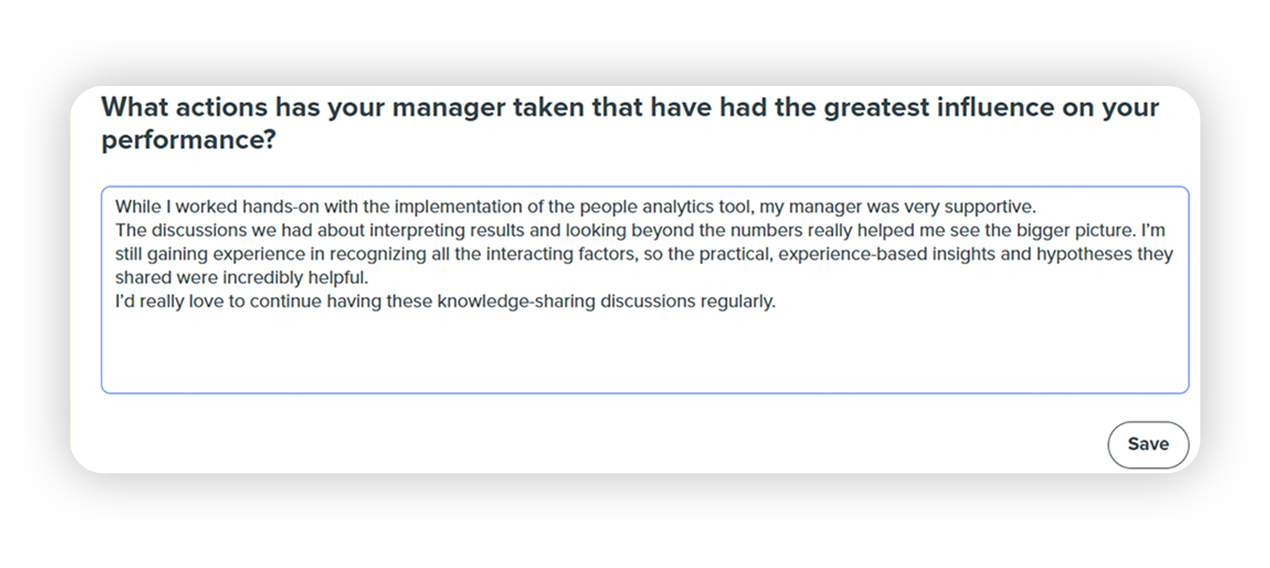
Who should lead and support the upward feedback process
The last but not the least important part of the 360 review template, this one is perfect for HR professionals aiming to strengthen leadership practices, executive teams focused on cultural health, and organizations committed to open, two-way feedback.
When to introduce upward feedback into a leadership 360 review
The upward performance review template is most effective when used annually or during a leadership performance review. It provides employees with a safe space to offer feedback on their managers, a practice that is increasingly common in progressive tech organizations that prioritize psychological safety and leadership effectiveness.
This review is particularly useful when assessing team health, leadership styles, and workplace culture, especially in organizations that value transparency and open communication.
When does this review type feel forced
Upward reviews should never be used as a tool for punitive action against managers or as a token exercise without real commitment to leadership development. They require a mature feedback culture and clear guidelines to be effective.
How to gather upward reviews that truly inform leadership
To make the most of the upward performance review, clearly communicate its purpose and ensure confidentiality. Focus on leadership behaviors, such as clarity in communication, recognition of team contributions, fairness, and responses to vulnerability. Use the insights to guide leadership development discussions and foster a culture of continuous improvement.
Make upward feedback safe, honest, and useful
✅ Set clear expectations. Feedback is for leadership growth, not criticism.
✅ Center questions on leadership behaviors, like communication and fairness.
✅ Ensure transparency in how feedback is used. Leaders must act on insights.
Why upward reviews are key to a healthy, feedback-driven culture
Upward feedback helps managers gain insights into how their leadership style affects team dynamics, clarity, fairness, and psychological safety. They create a feedback loop that supports leadership development and drives cultural improvements within the organization.
🗣️ Feedback that flows both ways?
This upward feedback template opens the door.
Effective 360 feedback begins with the right questions
360 review template from Kadar provides a comprehensive, skill-based approach to feedback and employee development. Each template is designed to facilitate structured conversations, encourage honest reflection, and yield actionable insights, all essential elements for building high-performing teams in the tech industry.
With editable templates available for self-assessment, peer review, direct report review, and upward review, this 360 review template supports HRs, managers, and team leaders in driving meaningful employee performance management processes.
How Kadar supports a structured, skill-based 360 review
We know that even the best frameworks fall flat without the right 360 review tools. That’s why we don’t just offer a 360 review template, but a system that fits naturally into your workflow, making it easy for teams to collect feedback, compare perspectives, and follow through on action plans.
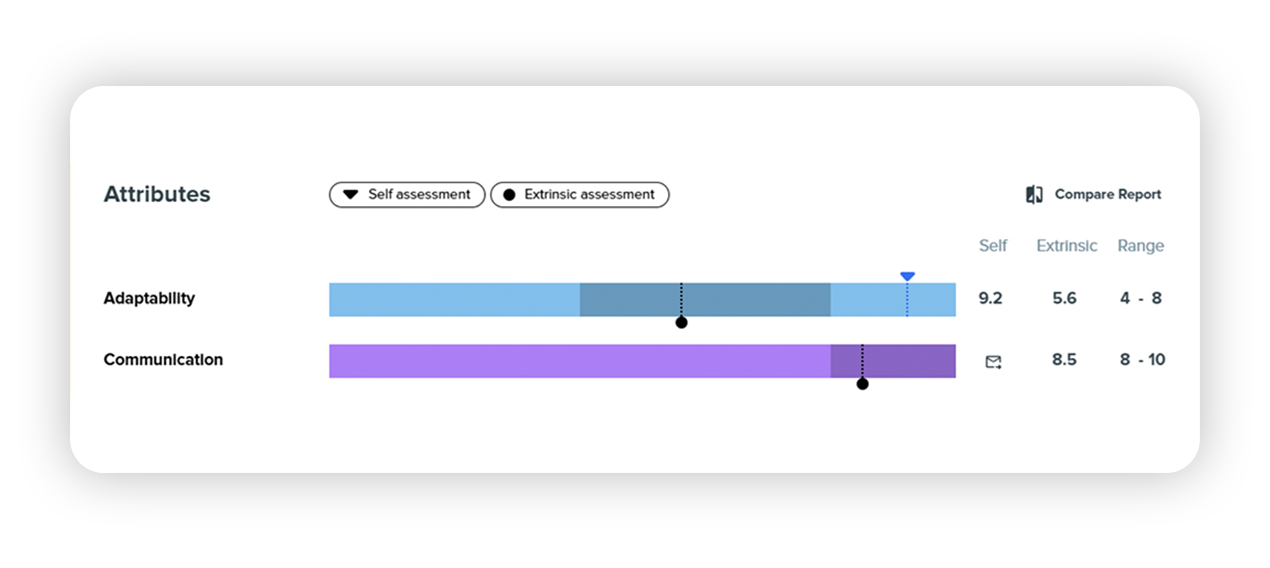
Once feedback is collected, all perspectives — self, peer, manager — come together in a single, clear view. This side-by-side comparison feature highlights patterns, reveals blind spots, and makes it easier to align expectations across the board. No spreadsheets, no scattered notes, just structured insights that support honest employee development discussions.
Also, gathering external feedback is just as simple. Need insights from clients or project partners? You can invite them into the 360 performance review without complicated licensing or admin overhead, keeping every perspective visible and actionable.
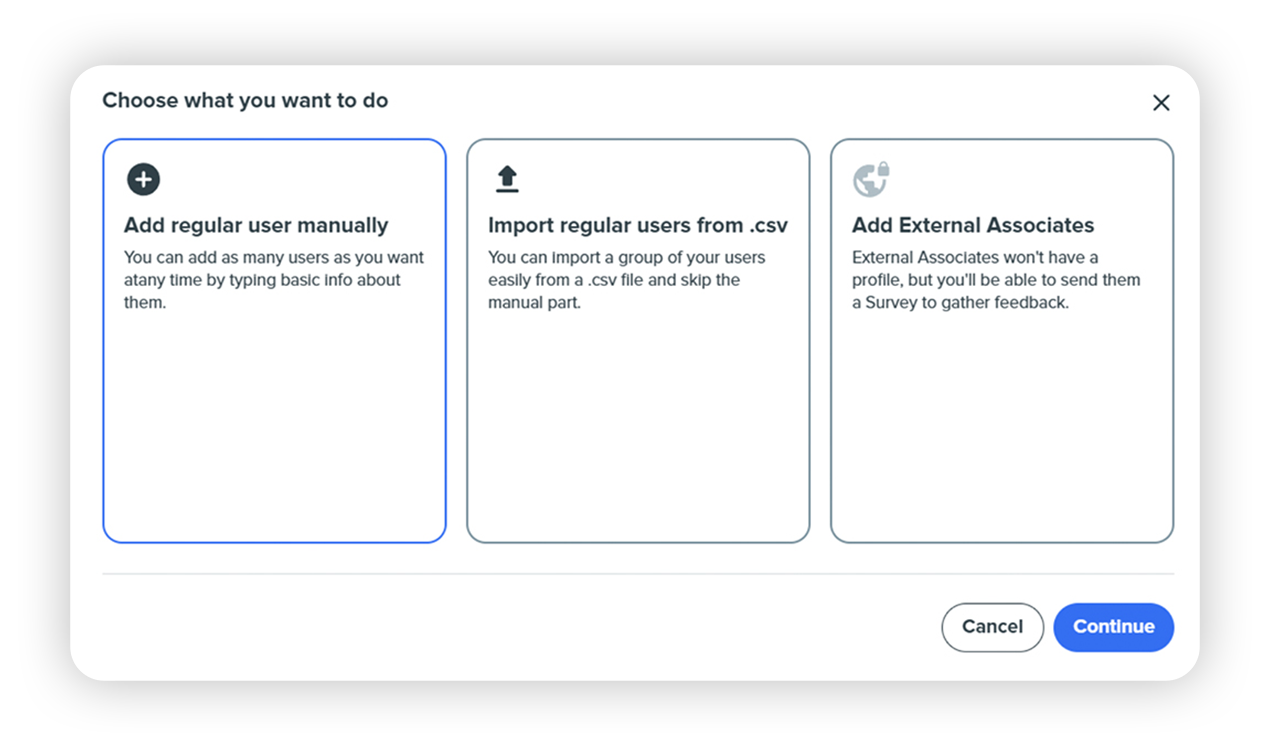
And because a 360 review only matters if it leads to action, Kadar ties every feedback cycle to structured action plans. Managers and employees can track skills development, follow up in future 1:1s, and keep progress visible over time without scattered notes or forgotten goals.
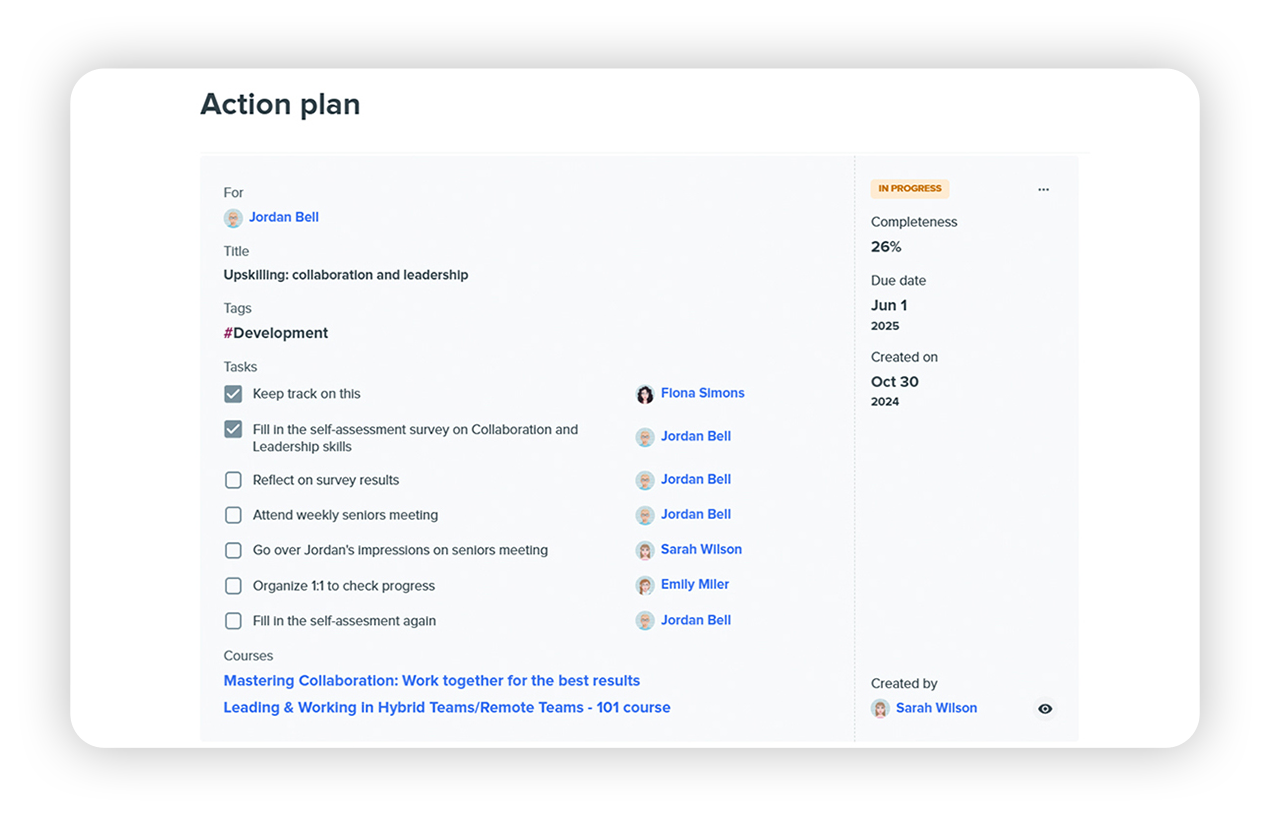
Designed to be intuitive, flexible, and supported by a responsive team, Kadar gives tech organizations a simple way to make reviews for 360 meaningful, not just once a year, but every time feedback matters.

